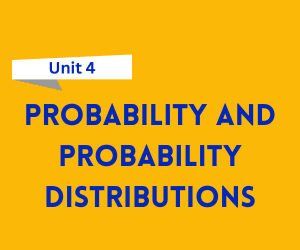In business and management, understanding how two or more variables are related is essential for making predictions, identifying trends, and making sound decisions. Correlation and regression analysis are powerful statistical tools used to examine the relationship between variables. While correlation quantifies the strength and direction of a relationship, regression goes a step further by enabling prediction of one variable based on another. This unit provides students with a practical framework to analyze data relationships for strategic decision-making.

Download Unit 4 – Correlation and Regression Analysis Notes
Get simplified revision notes for this unit:
Download Unit 4 Notes PDF
Correlation – Meaning and Types
Correlation measures the degree to which two variables move in relation to each other. It helps determine whether an increase (or decrease) in one variable results in a corresponding change in another.
Types of Correlation:
Positive Correlation – When both variables move in the same direction.
Example: Advertising spend and sales revenue.Negative Correlation – When one variable increases while the other decreases.
Example: Price of a product and its demand.No Correlation – When changes in one variable do not affect the other.
Example: Shoe size and intelligence.
Correlation values range from -1 to +1, where:
+1 indicates perfect positive correlation
-1 indicates perfect negative correlation
0 indicates no correlation
Karl Pearson’s Coefficient of Correlation
Karl Pearson’s method is the most commonly used technique to measure linear correlation between two continuous variables. It is denoted by r and calculated using the formula:
The result indicates:
r > 0: Positive correlation
r < 0: Negative correlation
r = 0: No linear correlation
Applications in Business:
Measuring the relationship between demand and price
Studying the link between employee satisfaction and productivity
Analyzing connection between investment in R&D and profitability
Spearman’s Rank Correlation
Spearman’s rank correlation is used when the data is ordinal (ranked) rather than numerical. It assesses how well the relationship between two variables can be described using a monotonic function.
Where dd is the difference between ranks and nn is the number of observations.
It is ideal when working with qualitative data such as employee rankings, customer satisfaction scores, or preference ratings.
Regression – Meaning and Types
Regression analysis is a statistical method used to model and analyze the relationship between a dependent variable and one or more independent variables. It allows businesses to predict future outcomes and make data-driven decisions.
Types of Regression:
Simple Linear Regression – Involves one independent and one dependent variable.
Multiple Regression – Involves more than one independent variable.
Non-linear Regression – Used when the relationship is not linear.
Simple Linear Regression – Equations and Forecasting
In simple linear regression, the relationship between two variables is expressed using a straight-line equation:
Y=a+bXY = a + bX
Where:
Y = Dependent variable (e.g., sales)
X = Independent variable (e.g., advertising spend)
a = Intercept (value of Y when X = 0)
b = Slope of the line (rate of change in Y with respect to X)
Using regression equations, businesses can forecast future trends, like predicting next month’s sales based on advertising investment or estimating employee performance based on training hours.
Why This Unit Is Important
This unit helps BBA students gain a deep understanding of how to analyze and interpret the relationship between variables. Whether you’re assessing customer satisfaction, predicting future sales, or evaluating employee performance, correlation and regression provide the foundation for accurate forecasting and strategic decisions. Mastering these techniques is essential for aspiring analysts, managers, and entrepreneurs in a data-driven world.
